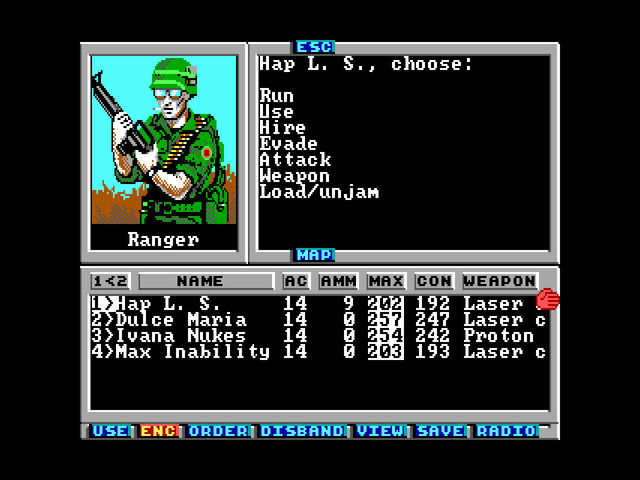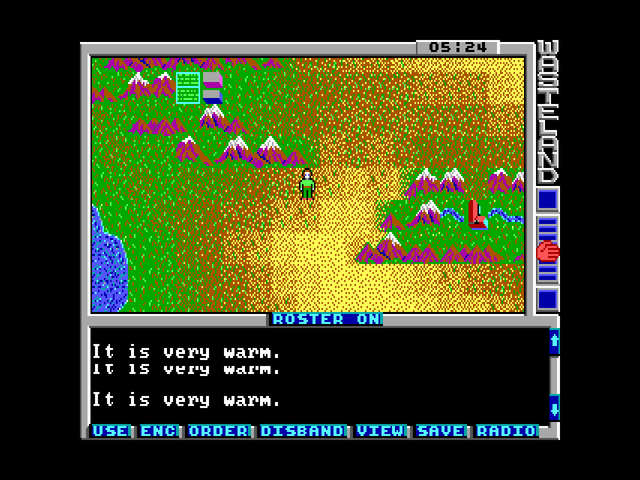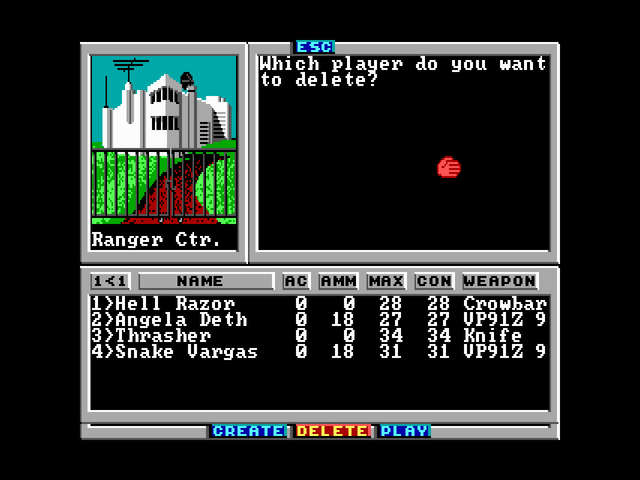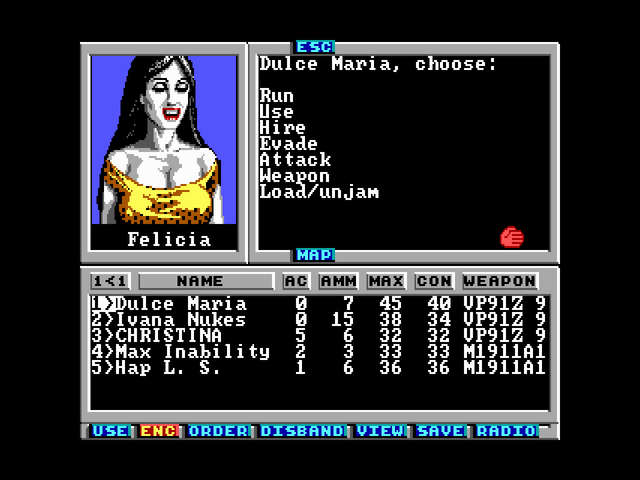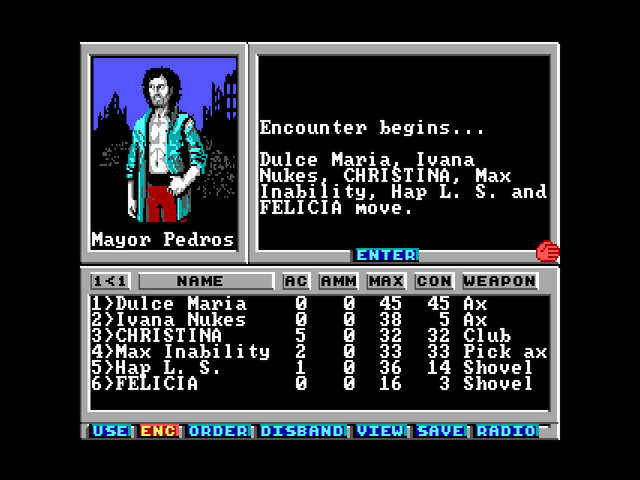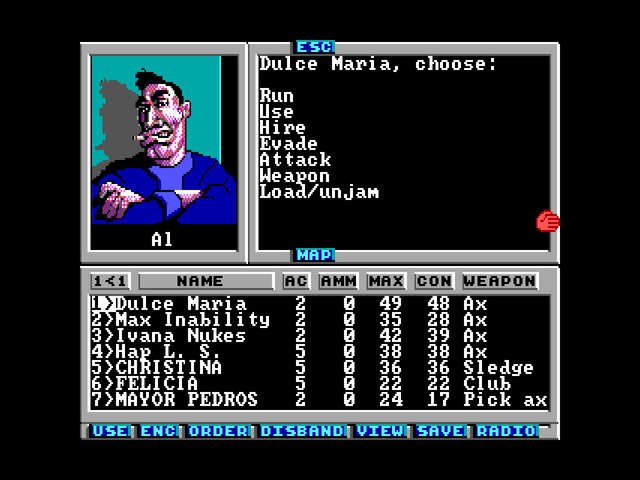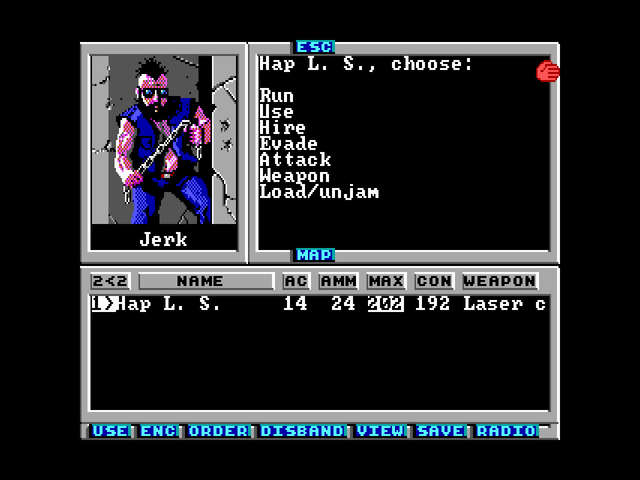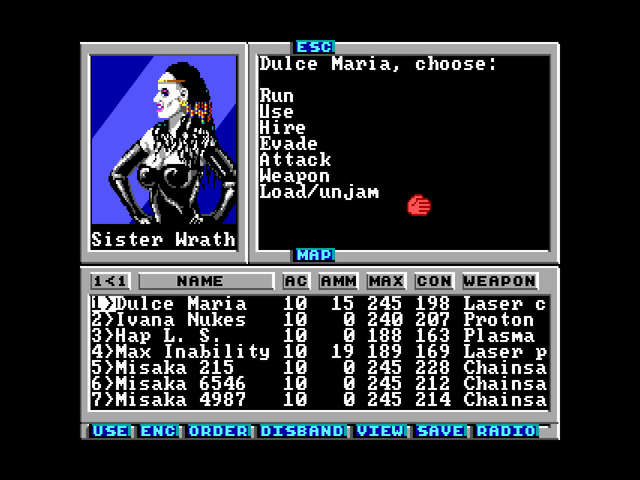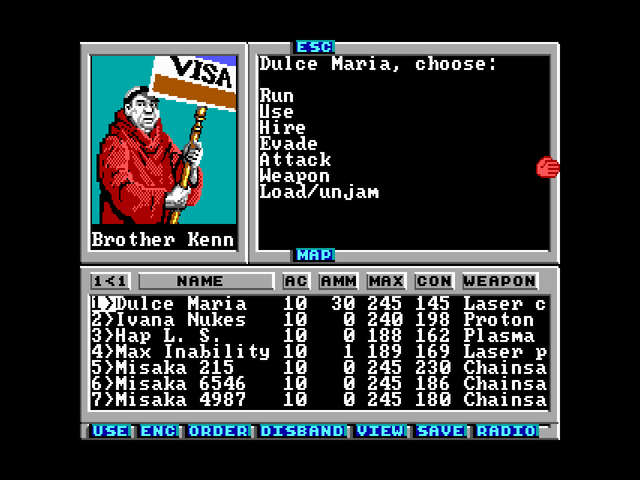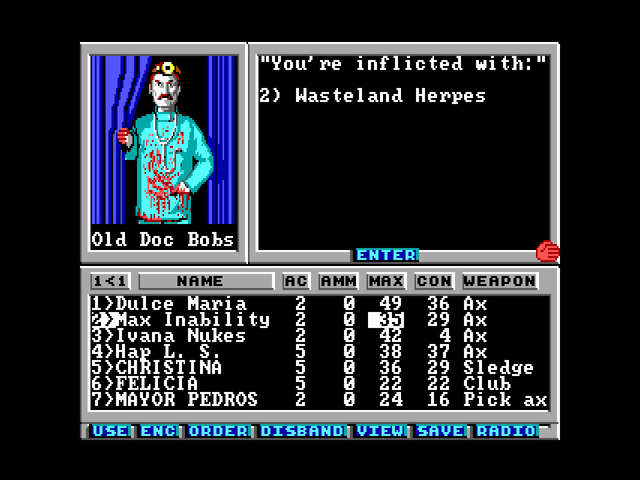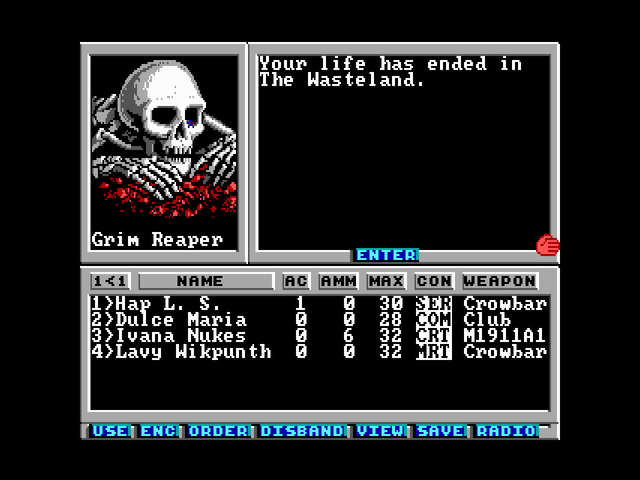Wasteland is one of those games that we usually hear about, know how influential it is, but never actually did more than boot it up and got intimidated by its open world design, clunky UI, and brutal difficulty. But it’s also one of those titles that are truly rewarding if you put enough effort to understand it and overcome its challenges.
The game is an open world CRPG developed by Interplay, the company behind cult classics like the Bard’s Tale trilogy, Battle Chess, Neuromancer (1988), and many Star Trek games. Its subsidiary, Black Isle Studios, was responsible for titles like the pre-Bethesda Fallouts, Planescape: Torment and Baldur’s Gate series.
Wasteland was released in January 1988 for the Apple II and later ported to the Commodore 64 and MS-DOS. It was re-released in 2013 as Wasteland 1: The Original Classic by inXile Entertainment, a company founded in 2002 by Interplay co-founder Brian Fargo, who was one of the original designers of the title. It included a few whistles and bells, like a sort of soundtrack, smoothed graphics and new portraits. It also got a remastered version in February 2020. It has completely new graphics, a few changes in gameplay and UI, and sound.
The game was a critical and commercial success, but unfortunately didn’t have a sequel until 2014, more than 30 years later. Wasteland is considered the inspiration for the original Fallout games, sharing similarities in themes, setting and Power Armor.
I played the re-release from 2013 with DOSBox-X, with the “pixel-perfect” output as it seemed a lot better than the stretched look of the stock game. Unfortunately, I lost the most interesting update (in-game paragraphs with voice-over), but it was a small loss, in my opinion.
Should you play it or spare yourself from nightmares?
The Narrative
In 1988 the United States and the Soviet Union finally attacked each other with nuclear weapons, destroying the Earth. After the atomic holocaust, a group of U.S. Army Engineers took hold of a federal prison on the southwestern United States. After expelling the inmates and accepting other survivors, the outpost grew and eventually became known as Ranger Center, house of the Desert Rangers, whose mission is to help fellow wasteland inhabitants. The game takes place in 2087, almost one hundred years after the end of civilization.
Everything starts with your characters leaving the Ranger Center to look for trouble in the radioactive desert plains. At the beginning you may feel lost and directionless, as at the earlier settlements you will find only loose events that you can completely ignore. But as soon as you reach Las Vegas, the main storyline picks up and will only let go at the ending.
There is a lot of leeway on how events play, so you can roleplay and live your own post-apocalyptic reality. There is no moral mechanics to stop you from killing entire cities, including important NPCs, letting characters stay forever strapped to a bomb, or running away from an enemy that must die to fulfill a quest, leaving them with their eternal virtual grudge against you.
Presentation
Wasteland sounds and looks very primitive. Graphics on maps are what you would expect on RPGs of the time, but there are only four sprites, one for yours and friendly NPCs, one for human enemies, another for radioactive animals and monsters, and a last one for robots. They have no animation whatsoever. By contrast, during battles encounters the enemies will be represented by well-drawn portraits that have some charming animations.
The game has no sound besides noises from the computer’s internal speakers, so if you want to play like it’s 1988, prepare your own songs or podcasts. The 2013 re-release comes with a companion soundtrack composed by Edwin Montgomery. It’s very atmospheric and fits well with the game’s desolate setting. The game comes with a free mp3 copy (at least on GOG). Oddly, there are two missing tracks, Savage Village and The Ballad of Faran Brygo.
Unfortunately, it’s like a playlist that plays on the background while you do your daily chores, as the songs will not match the locations you visit or in-game events. It’s the same as picking up songs to listen while playing the game, so feel free to choose what you prefer the most.
The same soundtrack was used for the 2020 remaster, plus a few additional tracks. You can listen to everything on the composer’s bandcamp.
Mechanics
Characters
The game starts at the Ranger Center, giving you four stock characters: Hell Razor, Angela Deth, Thrasher, and Snake Vargas. If you’re like me and prefer to create your own unbalanced party, roll their attributes (Strength, IQ, Lucky, Speed, Agility, Dexterity, Charisma, and Max Constitution – your HP), pick a post-apocalyptic fitting name, a nationality (?), and lastly choose some skills. Your rangers will receive some low-level equipment and will be sent on their way to find trouble throughout the merciless radioactive desert.
Naturally, your ragtag band of wasteland warriors won’t be complete without hiring a few more party members. You can have up to seven, and the game offers some interesting options, from a mayor and his wife, to a robot you must assemble. These characters have a will of their own, since they will refuse to comply to your commands on some occasions. They will also exercise their free will during battles by attacking however they see fit, usually wasting a lot of ammo.
It’s not a complex behavior pattern, but it gives your allies some personality. If this annoys you, there’s an awesome way around it. Spoiler alert: it involves cloning.
Skills
The game has a lot of different skills (more than 30), but it’s possible to loosely classify them in combat, social and environmental. Combat skills will increase a character’s performance in battles, usually giving them multiple attacks per turn and better proficiency with weapons and fists. Social skills are used to amuse or intimidate NPCs, while environmental skills serve to interact with the world, like lock picking doors, using electronic devices, disarming explosives, swimming, climbing, etc.
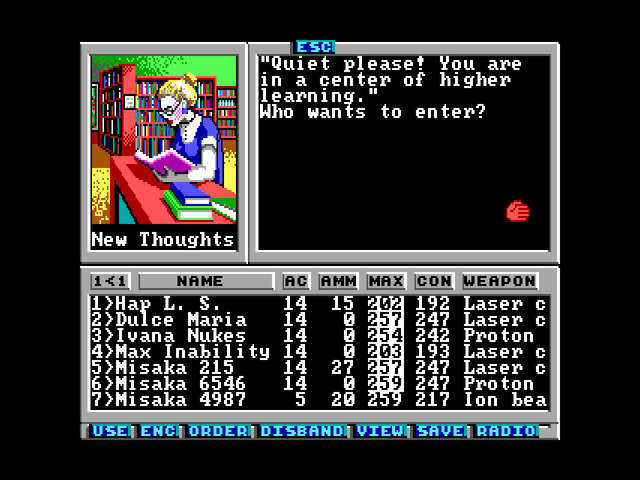
You can increase a skill’s level or buy new ones by spending skill points. Characters gain two points for every IQ point you have, so it’s always possible to increase the attribute to gain more. To learn a new skill or raise their level, go to a library and spend the necessary points on what you prefer.
Most abilities will cost one point, but some require two and a few special ones are bought by three. However, not all skills are available in every library, so you might have to do some leg work to find the one you want.
A skill’s level can also grow if you keep using them. This is a far better and faster alternative, since the number of points necessary to raise a skill’s level will double every new one. So, for skills bought for one point, you will need 2 points for level 2, four points for level 3, eight for level 4, and so on. As the necessary points rapidly increase, it becomes unfeasible to raise skills by investing in IQ.
Paragraphs
The “Paragraphs” was a printed booklet (a PDF file in the digital distributions) with 162 numbered text excerpts that complement the game’s events. Entries may contain important information, like a password, where to recover an item, or whom you should talk to progress. But don’t go reading without being asked to, as some have false info that may cause problems for your rangers. If you want to try your luck, there are some fun entries about a Martian adventure that will make you scratch your head and a few others that will outright threaten you.
The Paragraphs book is an interesting part of the game’s design, as it doubles as a way to deal with the size limit of floppy disks and as a form of copy protection, as you must have it to complete some of the game’s events, similar to password sheets but more integrated to the gameplay.
On the game’s re-release, the developers incorporated the paragraphs on the game, so you don’t need to go read the PDF file if you don’t wish to. They also included a voice-over to make the experience more streamlined. The same was done for the remaster.
The Open World
What makes Wasteland shine is its open world design. The world is not huge like in modern games, neither is stuffed of points of interest as in Ubisoft titles, but there is a lot of freedom on how you interact with what’s there.
You want to open a locked door? Try a character with the lock picking skill. No one has it? Maybe try to use the strength attribute to force it open. Only have wimps without skills on your party? Just blow everything up with TNT. Need to draw attention from NPCs? Try to impress them with skill or a charisma check. Some characters may become allies if you approach them the right way, others may turn into enemies or outright die because you entered a room with guns blazing instead of sneaking your way in.
According to its wiki and Wikipedia, Wasteland’s mechanics were based on two pen and paper RPGs, Tunnels & Trolls and Mercenaries, Spies and Private Eyes. That explains why you usually can tackle most problems by different means.
This flexibility is also reflected on how you can freely roam throughout the entire map, accessing most of its locations, and doing many of its quests right after leaving the Ranger Center. Logically, some of these activities are unfeasible for beginner characters.
Wasteland also features a persistent world, so dead characters stay dead, destroyed villages stay inhabitable, provoked NPCs will still try to murder you whenever you’re near them. Something that we take as granted nowadays, but an innovation at the time, as most games would reset the interactions previously done after you left the area, like in Ultima 1. On that game, no matter if you kill all residents of a city, if you leave and return everything goes back to the way they were when you first entered.
Modern players may feel that the world empty, with few activities and events. They are not wrong, Wasteland isn’t a huge game by contemporary standards. There are only a handful of cities to explore, with many empty buildings with the same internal layout, housing only venomous animals. It may leave a feeling of loneliness and desolation, perfect for a post-nuclear setting, but these are lost opportunities to engage the player. However, the game has a few secrets here and there, while its main quest is compelling enough to keep you hooked. I can’t deny that it’s biggest strength isn’t in having an Ubisoft map, but on how interesting the interactions it provides are.
Battle System
Wasteland uses an interesting turn-based system that, while clunky, offers ample choices to the player. The game also employs random encounters, with only a handful of story-related, obligatory battles. Funnily enough, you will have more random fights inside cities than while traversing the overworld.
Each round characters can attack, chose a new weapon, reload or unjam a gun, evade, move to another position, use an item, skill or attribute, or try to hire an enemy. There is no animation showing your actions, only some text with exaggerated descriptions of what’s happening on the battlefield. Some are funny, like “enemy is filled full of lead”, “brutally pummels the Brat”, or “spinning it into a dance of death”.
There are many types of firearms to find, from pistols to rifles, to more rifles, to laser weapons. Unfortunately, they require ammunition to function, something that isn’t readily available. It takes one turn to reload or unjam a gun, what usually slows the combat flow.
Another important aspect of firearms is the distance between you and your target. Some are suited only for short-range combat, like pistols and machine guns. Some enemies can start an encounter from afar, making it necessary to get closer to them or to switch to long-range weapons, what’s a problem in itself, because you probably want to save their ammunition for stronger foes, as they hit harder.
You can also engage in melee combat by using knives, fists, and any other imaginable item, like books and jewelry, as you can equip most of the game’s items. Logically, these inappropriate weapons will result in a less than desirable outcome. But remember, by resorting only to physical attacks distant enemies will get some free shots at you.
By investing in combat skills, you improve the chances of landing a hit, the number of attacks per turn, and in the case of firearms, lessening the possibility of a jam.
Unlike most RPGs, you can’t recover HP (constitution) during a fight, only by resting or by paying some hefty a doctor. Since your characters can die permanently, it can be very distressing when enemies incapacitate half of your party.
When a character loses all their life points, they will become unconscious. They will recover naturally with the passage of time, and may even wake up mid-battle, but if they get hit on this state, their condition will worsen. It will become serious, then critical, mortal, comatose, and finally they will die. If they survive the encounter you can go to a doctor and pay for him to stabilize the fallen character, or you can do it yourself with the medic skill. It’s possible to bring someone to unconscious state while fighting, but unless you are desperate and have a well-trained medic, I would advise to use all available hands to finish the enemy as soon as you can.
My biggest gripe with combat is how it feels unbalanced. You can complete the events on a city and be ruthlessly beaten on the next one, forcing you into a grind fest. That disrupts the gameplay, as you are forced to stop exploring or to put a halt on whatever quest you’re doing to level up, starting a routine of almost dying while fighting the stronger enemies, recovering by pressing ESC, with the eventual visit to a clinic – an adventure in itself – or the compulsive use of a low level medic skill, rinse and repeat. I can take some grind, but for a few times I felt bored and thought about not finishing the game.
Altogether, combat in Wasteland can be a brutal yet thrilling experience. The grinding can become annoying, but it’s very satisfying when your characters start to shape into hardened wasteland warriors, pulling off the most difficulty fights. Unfortunately, the flow of combat is a bit off when using firearms or when you must move too much, what forces you to navigate a lot of menus and take some free hits. Overall, it’s a good system that could see some fine-tuning.
Macros
Like in many RPGs, Wasteland’s gameplay is mostly done through various menus. It can become tiresome if you must repeatedly use a skill to get a hit if you need to press five keys each time, or to keep selecting every command for every character for every encounter, a sentiment that I know everyone will feel in at least one game.
To avoid the repetitive nature of the gameplay the game has a built-in macro system that is very easy to set up. It’s possible to record lots of different combinations, so you can have a dedicated key for a skill you use a lot, another one for saving without quitting, other that registered all your battle commands, etc. To register a macro:
- Hit the Windows key plus some of the F keys, from F1 to F10 (it’s not the Fn key!).
- The screen will show a message confirming it is recording a macro.
- Perform the desired actions.
- Hit the same combination of Windows key plus the chosen F key. It’s incredible that this never become a common mechanic in modern games, forcing players to use specialized software for the same functionality.
Final Thoughts
Despite its aged appearance, Wasteland feels like a modern RPG, even passing as advanced when taking into account how it lets the player solve problems in different manners. Its brutal combat and unbalanced difficulty require a lot of patience and dedication from the player, something hard to have nowadays with so many games that make battles less repetitive and more engaging. Yet I think the game deserves to be on any RPG fan backlog, as it has an intriguing setting, a good plot, fun enemies, and interesting characters that inhabit a cruel and merciless world. Finally, if you’re a fan of the Fallout games, it has a historical value as their predecessor and direct inspiration.
Differently from what I thought about Ultima 1, a game whose mechanics weren’t compelling and, in my opinion, would need a total overhaul if remade, Wasteland has a solid base that would benefit from some fine-tuning with a complete update of its graphics and sound. And that’s sort of what Inxile did with the game’s remaster.
Final opinion: Very recommended if you wish to sink long hours into an almost savage radioactive desert.


